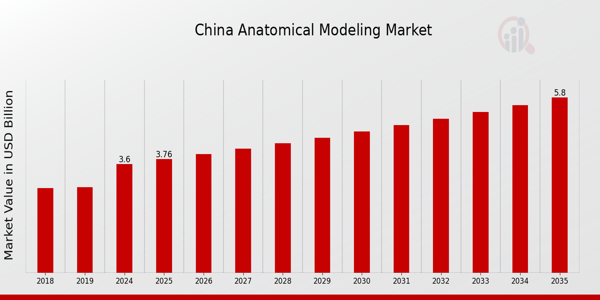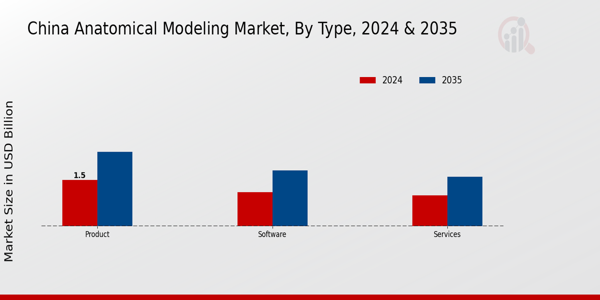China Anatomical Modelling Market Overview
As per MRFR analysis, the China Anatomical Modelling Market Size was estimated at 2.96 (USD Billion) in 2023. The China Anatomical Modelling Market Industry is expected to grow from 3.6 (USD Billion) in 2024 to 5.8 (USD Billion) by 2035. The China Anatomical Modelling Market CAGR (growth rate) is expected to be around 4.431% during the forecast period (2025 - 2035).
Key China Anatomical Modelling Market Trends Highlighted
Numerous different elements are influencing numerous notable trends in the China Anatomical Modelling Market. The growing emphasis on sophisticated healthcare techniques has fuelled the demand for high-quality anatomical models in educational institutions and healthcare facilities. The integration of 3D printing technology for anatomical models is increasing as China's healthcare industry keeps innovating. This technology offers tailored solutions that fit certain surgical and educational needs, hence improving the learning and operating experience for medical personnel. Furthermore, the increasing incidence of chronic illnesses and the aging population in China are driving more need for anatomical models.
These models help to clarify and plan treatments for various medical disorders, hence stressing their use in the healthcare system even more. Government efforts to enhance patient outcomes and medical training are also driving the industry ahead. There are also plenty of possibilities to be investigated in the field of virtual and augmented reality in anatomical modeling. Gaining popularity in China, these technologies provide creative methods to see complicated anatomical features, which may be especially useful for surgical planning and medical education.
Chinese businesses are set to dominate in the manufacture of sophisticated anatomical models, given their strong manufacturing foundation and dedication to research and development.
Academic institutions and businesses working increasingly together are driving creativity and improving market product offers. These trends point to a dynamic future for the China Anatomical Modelling Market, where developments are still influencing the environment.

Source: Primary Research, Secondary Research, Market Research Future Database and Analyst Review
China Anatomical Modelling Market Drivers
Growing Demand for Personalized Medicine
The trend towards personalized medicine is a significant driver of the China Anatomical Modelling Market Industry. Personalized medicine relies heavily on anatomical models for better comprehension of individual patient anatomy, enhancing treatment outcomes. The National Health Commission of China has reported a growing focus on precision medicine, with initiatives aiming to improve diagnostic capabilities and treatment customization in major hospitals.
This has led to a 20% increase in the adoption of 3D printing technologies for anatomical models in the last five years, according to data from the Ministry of Industry and Information Technology. This growth underscores the increasing integration of anatomical models in patient-specific treatment plans, thereby propelling market growth in China.
Development of Advanced Simulation Technologies
Technological advancements in simulation methods are revolutionizing the training and education sectors in medical institutions across China. The Chinese Ministry of Education has promoted simulation-based learning as a key component in medical education reforms, resulting in a reported 15% increase in medical students using anatomical models for practical training.
Collaborations between medical schools and tech companies have fostered the production of sophisticated anatomical modeling tools, enhancing realism and accuracy in medical training. The integration of these advanced simulation technologies within the curriculum is expected to drive the growth of the China Anatomical Modelling Market Industry significantly.
Increase in Surgical Procedure Volume
The escalating number of surgical procedures in China is another key driver for the China Anatomical Modelling Market Industry. The National Health Commission has reported a consistent rise in surgical interventions, with an estimated increase of over 10 million surgeries performed annually in recent years. This surge is primarily observed in orthopedic, cardiovascular, and cosmetic surgeries, which increasingly utilize anatomical models for pre-surgical planning and intra-operative guidance.
Major healthcare providers like Shanghai Ruijin Hospital have noted that the use of anatomical models has enhanced surgical outcomes and reduced operation times, leading to growing demand and investment in this market segment.
China Anatomical Modelling Market Segment Insights
Anatomical Modeling Market Type Insights
The China Anatomical Modelling Market reflects significant growth potential across various segments, including Product, Software, and Services. As China's healthcare infrastructure continues to evolve and the demand for advanced medical training and surgical planning grows, the market is seeing a shift towards more sophisticated anatomical models that cater to a range of clinical applications. The Product segment encompasses physical anatomical models, which have become essential tools used in medical schools, hospitals, and research institutions for educational purposes, surgical simulations, and patient consultations.
The rise in the adoption of these models is attributed to their ability to provide realistic representations of human anatomy, aiding healthcare professionals in improving their skills and enhancing patient care. In recent years, the role of Software in the China Anatomical Modelling Market has gained traction as digital solutions complement traditional modeling practices. Advanced 3D visualization software enables detailed anatomical reconstructions, which are increasingly utilized in preoperative planning and personalized medicine.
By enabling surgeons and medical personnel to visualize complex anatomical structures, software solutions significantly enhance precision in surgical procedures, thereby improving outcomes. Moreover, the integration of artificial intelligence and machine learning into software is likely to further streamline anatomical modeling processes, paving the way for future innovations in personalized treatment protocols. The Services segment plays a crucial role in supporting the anatomical modeling ecosystem in China by offering essential training, maintenance, and consulting services that accompany the use of both physical and digital models.
The increasing complexity of modern medical procedures necessitates ongoing training and support, resulting in a growing need for specialized services that cater to the healthcare industry. These services not only ensure the effective operation of anatomical models but also contribute to the continuous development of healthcare professionals through workshops and hands-on training sessions. Overall, the segmentation within the China Anatomical Modelling Market underscores a holistic approach to advancing medical education and practices, driven by the growing demand for precise and interactive modeling solutions.
Each segment complements the other, creating an interconnected landscape that fosters innovation and improves educational outcomes in the healthcare sector. The ability to integrate these components effectively will be vital for stakeholders aiming to capitalize on the market's growth trajectory, as the country emphasizes the importance of developing its medical infrastructure and enhancing the quality of care delivered to patients. As the market evolv

Anatomical Modeling Market End User Insights
The End User segment of the China Anatomical Modelling Market shows diverse applications across various sectors that highlight the market's depth. Hospitals and clinics are crucial to this segment as they require advanced anatomical models for surgical planning, patient education, and training, ensuring enhanced medical outcomes. Veterinary clinics are gaining momentum by utilizing these models for better diagnostic procedures, fostering the growth of animal health care in China. Academic institutions and education centers also play a fundamental role they employ anatomical models for teaching purposes, facilitating a superior learning experience in medical and health-related fields.
Furthermore, the segment labeled 'Others' encompasses various emerging sectors that utilize anatomical modeling in innovative ways, reflecting the overall need for effective training and research tools across industries. Currently, the China Anatomical Modelling Market is poised to capitalize on these opportunities, driven by an increasing focus on healthcare quality and innovations in educational methodologies. As the demand for improved healthcare delivery persists, the market can expect continuous growth influenced by advancements in technology, which allows for enhanced precision and accessibility.
China Anatomical Modelling Market Key Players and Competitive Insights
The China Anatomical Modelling Market is characterized by a rapidly evolving landscape shaped by advancements in medical technology, which are increasingly integrated into educational and surgical practices. This market has gained traction due to the rising demand for innovative anatomical models that improve training and surgical planning. Furthermore, the market is fueled by the growth of medical education programs and an increasing focus on patient simulations in clinical practices. Competitive dynamics are influenced by a blend of local and international players, each striving to develop cutting-edge solutions that cater to a diverse clientele comprising hospitals, educational institutions, and research facilities.
The competitive insights reveal a landscape where innovation, quality, and compliance with stringent regulations play pivotal roles in determining market success.
Nanjing Jilesi Medical Technology has established a strong foothold within the China Anatomical Modelling Market, positioning itself as a leader in the production of high-fidelity anatomical models. Their commitment to leveraging advanced manufacturing techniques allows them to create highly detailed replicas that are useful in teaching and surgical scenarios. Nanjing Jilesi Medical Technology's dedication to research and development enables them to stay ahead of industry trends and adapt to the changing needs of their customers. The company excels in providing personalized solutions tailored to educational institutions and hospitals, ensuring that their products meet the rigorous demands of the medical community.
By fostering collaborations with various academic institutions, Nanjing Jilesi has significantly enhanced its market presence, which is bolstered by a reputation for reliability and quality in anatomical modeling.
Guangdong Kangjian Medical is another prominent player in the China Anatomical Modelling Market, renowned for its diverse range of anatomical models and educational tools. The company emphasizes innovation in developing products that cater to the educational, training, and surgical needs of healthcare professionals. Their offerings encompass a wide array of anatomical models, including advanced surgical simulators and specialized training equipment, which are designed to enhance hands-on learning experiences. Guangdong Kangjian Medical has a strong market presence facilitated by strategic partnerships and collaborations aimed at expanding their reach within the medical community.
Their strengths lie in the ability to rapidly integrate user feedback into product development, agile manufacturing capabilities, and a robust distribution network. Additionally, the company has pursued mergers and acquisitions as part of its growth strategy to enhance its product portfolio and improve its technological capabilities, securing a competitive edge in the China Anatomical Modelling Market.
Key Companies in the China Anatomical Modelling Market Include
- Nanjing Jilesi Medical Technology
- Guangdong Kangjian Medical
- Shanghai United Imaging Healthcare
- Shenzhen Huada Technology
- Mindray Medical International
- Xiamen Kexin Medical Technology
- Tianjin Medical University General Hospital
- Beijing Huiying Medical Technology
- Shenzhen Best Medical Technology
- Beijing Jinshan Science and Technology
- Wuhan Jinxin Medical Technology
China Anatomical Modelling Market Industry Developments
In recent months, the China Anatomical Modelling Market has witnessed significant developments and changes, reflecting the growing demand for advanced medical technologies. Companies such as Nanjing Jilesi Medical Technology and Guangdong Kangjian Medical are actively enhancing their product offerings to align with global healthcare needs. In particular, Beijing Sivan Technology and Hangzhou Guojin Medical have been engaging in Research and Development initiatives focused on improving anatomical modeling processes. Notably, there have been discussions around potential mergers and acquisitions, although no recent deals among the specified companies have been publicly confirmed as of October 2023.
The market has also seen a rise in the overall valuation of key players like Mindray Medical International and Xiamen Kexin Medical Technology, positively impacting the competitive landscape. Growth in healthcare investments has been pivotal in advancing technological capabilities within the sector. In the past two to three years, significant milestones include the increased adoption of 3D printing technologies by companies like Shenzhen Huada Technology and Beijing Huiying Medical Technology, indicating robust progress in the anatomical modeling field. The heightened focus on surgical precision and customization is expected to further drive market innovations going forward.
China Anatomical Modelling Market Segmentation Insights
Anatomical Modeling Market Type Outlook
Anatomical Modeling Market End User Outlook
- Academic Institutions & Education Centers
| Report Attribute/Metric Source: |
Details |
| MARKET SIZE 2018 |
2.96(USD Billion) |
| MARKET SIZE 2024 |
3.6(USD Billion) |
| MARKET SIZE 2035 |
5.8(USD Billion) |
| COMPOUND ANNUAL GROWTH RATE (CAGR) |
4.431% (2025 - 2035) |
| REPORT COVERAGE |
Revenue Forecast, Competitive Landscape, Growth Factors, and Trends |
| BASE YEAR |
2024 |
| MARKET FORECAST PERIOD |
2025 - 2035 |
| HISTORICAL DATA |
2019 - 2024 |
| MARKET FORECAST UNITS |
USD Billion |
| KEY COMPANIES PROFILED |
Nanjing Jilesi Medical Technology, Guangdong Kangjian Medical, Beijing Sivan Technology, Hangzhou Guojin Medical, Shanghai United Imaging Healthcare, Shenzhen Huada Technology, Mindray Medical International, Xiamen Kexin Medical Technology, Tianjin Medical University General Hospital, Beijing Huiying Medical Technology, Shenzhen Best Medical Technology, Beijing Jinshan Science and Technology, Zhejiang Havi Medical, Wuhan Jinxin Medical Technology |
| SEGMENTS COVERED |
Type, End User |
| KEY MARKET OPPORTUNITIES |
Increasing healthcare investments, Rising demand for personalized medicine, Advancements in 3D printing technology, Growth in medical education and training, Expanding telemedicine services. |
| KEY MARKET DYNAMICS |
Technological advancements in 3D printing, Rising demand for personalized healthcare, Increasing investment in medical education, Growing prevalence of chronic diseases, Enhanced research and development funding |
| COUNTRIES COVERED |
China |
Frequently Asked Questions (FAQ):
The China Anatomical Modeling Market is expected to be valued at 3.6 billion USD in 2024.
By 2035, the overall market size for the China Anatomical Modeling Market is expected to reach 5.8 billion USD.
The expected CAGR for the China Anatomical Modeling Market from 2025 to 2035 is 4.431 percent.
The 'Product' segment is projected to dominate the market, valued at 2.4 billion USD by 2035.
The Software segment is expected to be valued at 1.1 billion USD in 2024.
Major players in the China Anatomical Modeling Market include Nanjing Jilesi Medical Technology, Guangdong Kangjian Medical, and Beijing Sivan Technology.
The Services segment is expected to reach a market value of 1.6 billion USD by 2035.
Key growth drivers include advancements in medical technology and increasing demand for personalized healthcare solutions.
Current global dynamics are expected to influence the market positively by driving innovations and investments in healthcare.
The market faces challenges like stringent regulations and the high costs associated with advanced medical technology.
















